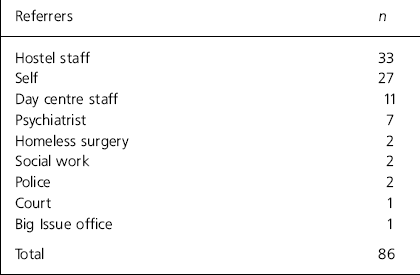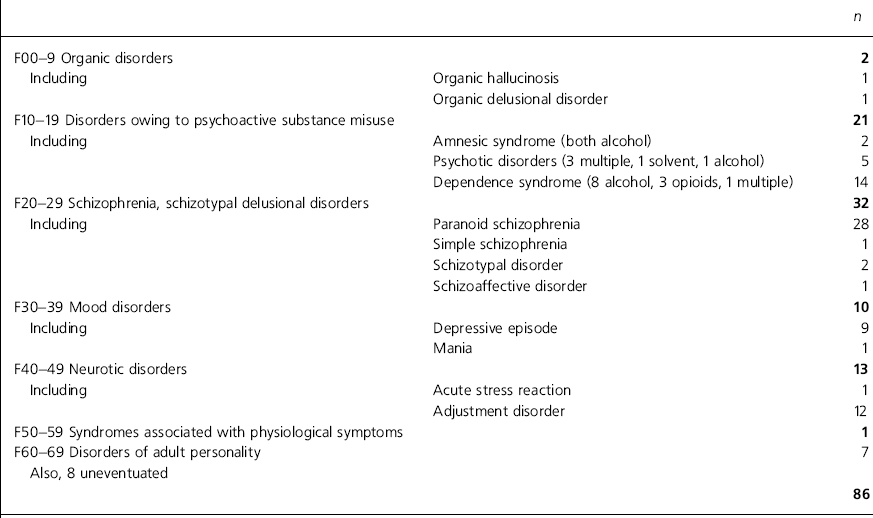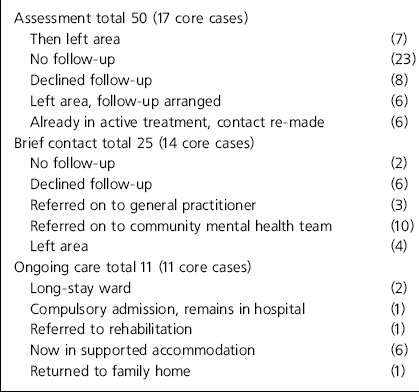The problems experienced by homeless people have been of increasing concern to those who provide health and social care over the past two decades. This coincides with increasing numbers of the homeless living on the streets and an emerging trend towards more young people and women appearing in the homeless population (Reference George, Shanks and WestlakeGeorge et al, 1991). Researchers have consistently found a marked increase in the prevalence of mental disorders among the homeless compared with the general population. Schizophrenia, affective disorders and substance misuse are particularly evident, and comorbidity among these, and other health problems, is common (Reference ScottScott, 1993).
Studies of homeless people have usually taken place in large cities. Aberdeen, a small, provincial city with a healthy economy, has a homeless population of approximately 2000, 62% of whom are single, living predominantly in bed and breakfast accommodation, hostels and temporarily with friends (J. G. Love, 1997, personal communication). In 1989/1990, a random sample of 75 residents of the largest short-stay hostel in Aberdeen indicated that one in four had mental illness. Eight per cent had current symptoms of psychotic illness and 13% were clinically depressed. In addition, 57% were dependent on alcohol. Half of all residents were not registered with a local general practitioner, thus denying them access to specialist mental health services. Untrained hostel staff showed considerable skill in picking out those who had serious mental illness (Reference SclareSclare, 1997).
Homeless people are difficult to engage in treatment because they tend to be self-sufficient, mistrustful and mobile. There are now a number of specialist services offering care to the homeless with mental illness and a variety of models have been set up (Reference Williams and AveburyWilliams & Avebury, 1995). As yet there is insufficient evidence to determine which are most successful.
Grampian Health Board, Aberdeen, explored options for a specialist mental health service for the homeless in response to local and national interest. Funding enabled the appointment of a community psychiatric nurse (CPN; A.W.) in April 1996. The CPN is linked to an established adult mental health team with access to in-patient facilities.
Previously, homeless referrals often presented in crisis and were allocated to a variety of consultant psychiatrists determined by a ‘no fixed abode’ rota. This group included visitors and tourists as well as the homeless.
It was proposed that the service should increase the accessibility of mental health services to the homeless population. On coming into post, the CPN made contact with agencies that have contact with homeless people. It was decided that the CPN should work on an outreach basis, spending time in venues used by homeless people. This allows the self-referrals ease of access and also enables staff at these venues to arrange for their clients to attend when the CPN is there. Outside these times the CPN can be contacted by use of a mobile telephone and effort is made to respond quickly to any referral. Venues used include hostels managed by the housing department, voluntary agencies and the direct-access hostel managed by the social work department. A drop-in for homeless people and the Big Issue Scotland office are visited regularly. It has been found that homeless people find being seen in these surroundings to be less threatening. Regular visits also allow the staff an opportunity to discuss any mental health issues and seek information and advice.
The CPN is part of the adult mental health community psychiatric nursing service and is managed by the CPN nurse manager. It is seen as important that the CPN remains part of the hospital team, although the majority of the role involves working with statutory and voluntary agencies outside the health service. The CPN maintains links with the community mental health team and inpatient ward by attending the weekly meetings. The CPN has a weekly, 1-hour supervision session with the consultant psychiatrist, who has medical responsibility for the patients on the CPN case-load. Each patient is regularly discussed and input reviewed. These meetings also provide opportunity for the progress of the service to be monitored and new ideas discussed.
The study
All patients referred to the homeless project were seen by the CPN (A.W.). A demographic questionnaire was completed for each referral, and information sought on current psychiatric symptoms and any previous contact with the mental health services. All referrals were discussed during weekly supervision sessions between the CPN and consultant psychiatrist (P.S.), and each individual was given an ICD-10 (World Health Organization, 1992) diagnosis. Thereafter, clinical records were maintained for each patient while they remained in contact with the service.
Findings
Routes of referral
Of the 86 patients referred to the services in the 3-year period between April 1996 and April 1999, 64 were male. The average age was 35.8 years (s.d.=11.02). The vast majority of referrals came from social care staff working at a local authority short-stay hostel or a day centre for the homeless, and from individuals referring themselves after seeing posters that advertised the service. There were no referrals from the only night shelter in Aberdeen, which is managed by a voluntary organisation whose religious beliefs make them antagonistic towards accepting any model of mental illness. The sources of referral are shown in Table 1.
Table 1. Source of referrals for the service

| Referrers | n |
|---|---|
| Hostel staff | 33 |
| Self | 27 |
| Day centre staff | 11 |
| Psychiatrist | 7 |
| Homeless surgery | 2 |
| Social work | 2 |
| Police | 2 |
| Court | 1 |
| Big Issue office | 1 |
| Total | 86 |
Diagnosis
Each individual was assigned only to the axis of mental state disorders. A wide range of diagnostic categories are found, as shown in Table 2. Forty-two out of 86 (49%) referrals can be considered to be the ‘core cases’ (organic psychoses, amnesic syndrome, psychotic disorders owing to psychoactive substance misuse, schizophrenia and severe mood disorders), comprising the target population for the homeless service.
Table 2. ICD-10 (World Health Organization, 1992) diagnoses of 86 assessed patients

| n | ||
|---|---|---|
| F00-9 Organic disorders | 2 | |
| Including | Organic hallucinosis | 1 |
| Organic delusional disorder | 1 | |
| F10-19 Disorders owing to psychoactive substance misuse | 21 | |
| Including | Amnesic syndrome (both alcohol) | 2 |
| Psychotic disorders (3 multiple, 1 solvent, 1 alcohol) | 5 | |
| Dependence syndrome (8 alcohol, 3 opioids, 1 multiple) | 14 | |
| F20-29 Schizophrenia, schizotypal delusional disorders | 32 | |
| Including | Paranoid schizophrenia | 28 |
| Simple schizophrenia | 1 | |
| Schizotypal disorder | 2 | |
| Schizoaffective disorder | 1 | |
| F30-39 Mood disorders | 10 | |
| Including | Depressive episode | 9 |
| Mania | 1 | |
| F40-49 Neurotic disorders | 13 | |
| Including | Acute stress reaction | 1 |
| Adjustment disorder | 12 | |
| F50-59 Syndromes associated with physiological symptoms | 1 | |
| F60-69 Disorders of adult personality | 7 | |
| Also, 8 uneventuated | 7 | |
| 86 |
Outcome
We have categorised the intervention by the homeless service as being ‘assessment’ (one or two clinical interviews, liaison with colleagues, references to past records during which the patient's problems are formulated), ‘brief contact’ (a maximum of five sessions with the CPN and/or psychiatrist) and ‘ongoing care’ (patient has longterm contact with the homeless service or the local psychiatric services). Details of the outcomes of each of these three interventions are outlined in Table 3. Almost half the total referrals to the homeless service were core cases. The outcome data indicate that this proportion was much less for those only offered assessment and much greater for individuals who received more intensive packages of treatment.
Table 3. The outcomes of patients referred to the service

| Assessment total 50 (17 core cases) | |
| Then left area | (7) |
| No follow-up | (23) |
| Declined follow-up | (8) |
| Left area, follow-up arranged | (6) |
| Already in active treatment, contact re-made | (6) |
| Brief contact total 25 (14 core cases) | |
| No follow-up | (2) |
| Declined follow-up | (6) |
| Referred on to general practitioner | (3) |
| Referred on to community mental health team | (10) |
| Left area | (4) |
| Ongoing care total 11 (11 core cases) | |
| Long-stay ward | (2) |
| Compulsory admission, remains in hospital | (1) |
| Referred to rehabilitation | (1) |
| Now in supported accommodation | (6) |
| Returned to family home | (1) |
Overall, we were able to establish ongoing contact with only 11 out of 42 individuals who presented with serious and enduring mental illness. Twelve patients (with a total of 16 admissions), all of whom had a diagnosis of schizophrenia or schizoaffective disorder, were admitted to an acute psychiatric bed while in contact with the homeless service. There were 774 total in-patient days and length of stay ranged from 2 to 165 days (median 22.5). Only one was a compulsory admission.
Discussion
We had a number of concerns when setting up the service for the homeless with mental illness in Aberdeen. We were not sure whether there would be adequate numbers of core cases of serious mental illness to justify a specialist service, and whether it would be possible to identify and engage these individuals in treatment. In addition, the service could be overwhelmed by requests to review homeless people who were in distress and/or misusing drugs and alcohol, but who did not have symptoms of treatable mental illness. From the outset we wished to maintain close links with colleagues in the adult psychiatric services, while establishing links with other homeless agencies who do not traditionally have such close contact with mental health professionals.
Our experience, thus far, suggests that we have been able to attract referrals for core cases, and that a significant proportion has engaged with the service and chosen to settle locally. It is impossible to determine how many core cases within the homeless population have not been referred, although there is evidence that untrained staff who work with the homeless have considerable skill in picking out those who are mentally ill (Reference SclareSclare, 1997; Reference MarshallMarshall, 1989). Homeless individuals with less severe mental health problems have been assessed and referred on to more appropriate services.
This project has confirmed that individuals with serious mental illness can be found among the homeless in small cities. By appointing one specialist CPN, realigning the existing psychiatric services and establishing working relationships with colleagues in social work, housing and the voluntary sector, it has been possible to identify and treat a significant number of homeless people who otherwise would remain symptomatic and rootless.






eLetters
No eLetters have been published for this article.